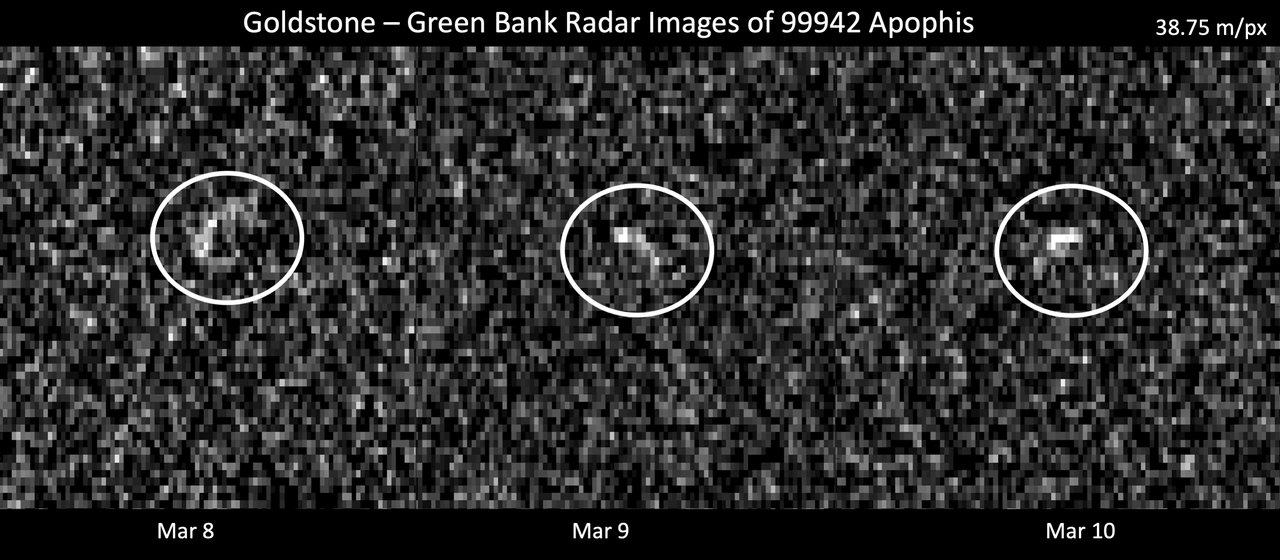Infamous asteroid Apophis poses no threat to Earth for at least 100 years, NASA says

The notorious Apophis space rock just shed its hazardous status — for the next 100 years at least — after fresh observations of the near-Earth asteroid.
Astronomers have been keeping an eye on Apophis since its discovery in 2004, after initial estimations based on a more preliminary orbit suggested it would come uncomfortably close to our planet in 2029. Apophis’ large size added to this concern, as it stretches 1,100 feet (340 meters) across — about 10 times larger than the object that created Meteor Crater in Arizona.
After refining the initial observations, astronomers found that there was no real risk of impact in 2029. Now, after Apophis safely passed by Earth earlier this month, there’s more good news: the asteroid won’t hit Earth in 2068 either. The space rock has also been removed from a risk list known as the Sentry Impact Risk Table, which is maintained by NASA's Center for Near-Earth Object Studies (CNEOS), which is managed by the agency’s Jet Propulsion Laboratory.
Related: Huge Asteroid Apophis Revealed in Photos
The Sentry Impact Risk Table is a set of asteroids that show asteroids grazing so close to Earth that a future impact can't be ruled out. This “risk list” tracks asteroids that are predicted to get close enough to Earth to where there is the possibility of impact, although happily, there are no imminent threats known to our planet..
"When I started working with asteroids after college, Apophis was the poster child for hazardous asteroids," Davide Farnocchia, who analyzes asteroid orbits at CNEOS, said in a statement.

"There's a certain sense of satisfaction to see it removed from the risk list, and we’re looking forward to the science we might uncover during its [next] close approach in 2029," Farnocchia added. In 2029, Apophis will zoom by Earth at roughly 20,000 miles (32,000 kilometers) from our planet's surface, a little closer than geosynchronous orbiting satellites.
Sign up for the Live Science daily newsletter now
Get the world’s most fascinating discoveries delivered straight to your inbox.
This new information came from observations of Apophis' flyby of Earth on March 5, when the rock swooped within 0.11 astronomical units, with 1 AU representing the distance between the Earth and the sun (93 million miles or 150 million kilometers), of Earth. With observations of this flyby, astronomers used radar to further refine our understanding of Apophis' path around the sun.
The radar telescope at Puerto Rico's Arecibo Observatory unfortunately retired a few months ago after it collapsed in 2020, but observations were still possible with facilities such as the Deep Space Network's Goldstone complex in California and the Green Bank Telescope in West Virginia. The various telescopes showed good news for an asteroid that has been deemed a risk for half a generation.
"A 2068 impact is not in the realm of possibility anymore, and our calculations don’t show any impact risk for at least the next 100 years," Farnocchia said. This allowed the group to remove Apophis from the risk list
Goldstone and Green Bank worked together to obtain imaging of Apophis, with Goldstone transmitting a radar signal and Green Bank receiving the reflection. The resulting radar imagery was pixelated, but still showed a resolution of roughly 38.75 meters (127 feet) per pixel.
"If we had binoculars as powerful as this radar, we would be able to sit in Los Angeles and read a dinner menu at a restaurant in New York," said JPL scientist Marina Brozovic, who led the radar campaign, in the same statement.
This new imagery will grow our understanding of asteroids. Also, using these observations, the teams studying the asteroid hope to figure out its shape; previous observations suggested that Apophis might be shaped like a peanut.
They also want to learn about the asteroid's rotation rate and its axis spin, which will help predict what orientation the asteroid has with Earth when it flies by in 2029. The close encounter with our planet could harmlessly change the asteroid spin state or cause "asteroid quakes" on the rock’s surface, the team said.
The CNEOS information is fed to NASA's Planetary Defense Coordination Office, which works with telescopes and institutional partners in the United States and worldwide to get the latest information about threats small bodies may pose to Earth.
Follow Elizabeth Howell on Twitter @howellspace. Follow us on Twitter @Spacedotcom and on Facebook.

Elizabeth Howell was staff reporter at Space.com between 2022 and 2024 and a regular contributor to Live Science and Space.com between 2012 and 2022. Elizabeth's reporting includes multiple exclusives with the White House, speaking several times with the International Space Station, witnessing five human spaceflight launches on two continents, flying parabolic, working inside a spacesuit, and participating in a simulated Mars mission. Her latest book, "Why Am I Taller?" (ECW Press, 2022) is co-written with astronaut Dave Williams.










